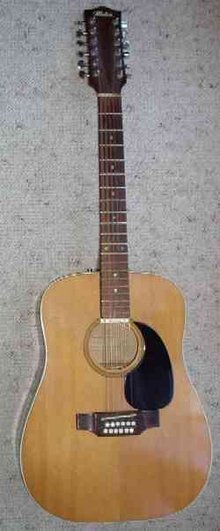Twelve string guitar
|
|
The twelve string guitar is an acoustic or electric guitar with twelve strings, which produces a richer, more ringing tone than a standard six string guitar.

The strings are placed in courses of two strings each that are usually played together. The two strings in each bass course are normally tuned an octave apart, while each pair of strings in the treble courses is tuned in unison. The tuning of the second string in the third course (G) varies: some players use a unison string which is less prone to breakage, others prefer the distinctive high-pitched, bell-like quality an octave string makes in this position.
The tension placed on the instrument by the strings is great, and because of this, 12 string guitars have a reputation for warping after a few years' use. Some 12 string guitars have nontraditional structural supports to prevent or postpone such a fate, at the expense of appearance and tone. Until recently, 12 string guitars were nearly universally tuned lower than the traditional EADGBE, to reduce the stresses on the instrument.
Many performers who play the 12 string guitar use an ordinary six string guitar as their primary instrument, switching to the 12 string guitar for certain songs that seem to call for a brighter sound.
Because it is substantially more difficult to pluck individual strings on the 12 string guitar, and almost impossible to bend notes tunefully, the instrument is rarely used for lead musical parts. It is primarily suited to a rhythm, accompaniment, or solo role, and is often used in folk songs and some popular music. Some hard rock and progressive rock musicians use double necked guitars which have both six-string and twelve-string components, allowing the guitarist easy transition between different sounds.
The greater number of strings complicates playing, particularly for the right hand. The gap between the dual-string courses is usually narrower than that between the single-string courses of a conventional six-string guitar, so more precision is required with pick or fingertip when not simply strumming chords. The pairing of thin, easily broken, octave strings with larger, stiffer bass strings presents difficulties to the player also, and only a very skilled player can reliably pluck single strings from within a course at any speed (notably the very high octave G string, which is the highest-pitched string on the instrument). Nevertheless, with practice the 12-string guitar is not unduly difficult to play. It is, however, generally used in a fairly restricted role which emphasises its strengths: rich ringing, full-bodied chords, and fast, rippling single plucked notes on the twinned strings.
The 12-string requires a little more left-hand strength than a standard 6-string guitar but, because it is in any case unsuited to bent notes, leads to more emphasis on finger speed (which is relatively easy to acquire) than on the more difficult techniques of the traditional lead guitarist. The greater string tension and the heavier construction tend to lead to an instrument with less natural sustain, and because it requires a good deal of left-hand finger-strength to keep the courses fretted firmly, the player's natural tendency is toward shorter notes. The result is that much 12-string playing is a little like banjo playing: it gravitates toward rhythmic sequences of fast, ringing notes and chords, because this is what the instrument produces most readily and (according to many players) most effectively.
12-string guitars are made in both acoustic and electric form, however it is the acoustic type that is most common.
Noted 12-string performers include
- Slash
- Johnny Marr
- Jim (b.k.a. Roger) McGuinn
- Melissa Etheridge
- George Harrison
- Jimmy Page
- Blind Willie Johnson
- Leo Kottke
- Leadbelly
- Blind Willie McTell
- Anthony Phillips
- Mike Rutherford
- Pete Seeger
- Marty Willson-Piper of The Church
External links
History of the 12-string (http://www.frets.com/FRETSPages/History/12string/12stOrigins.html)

